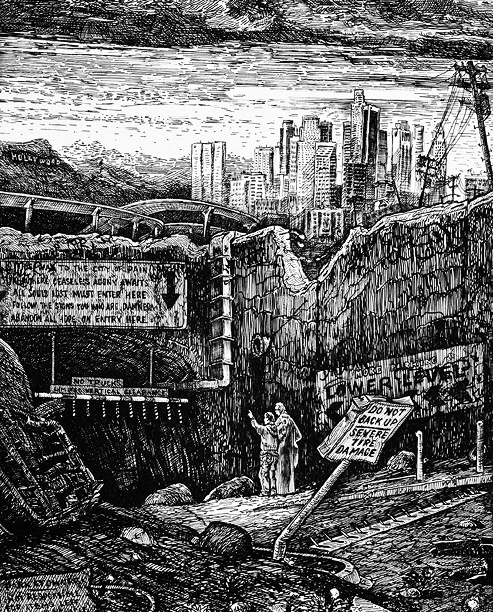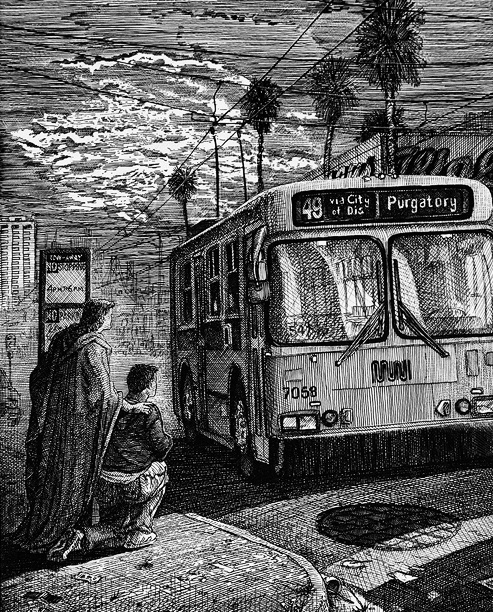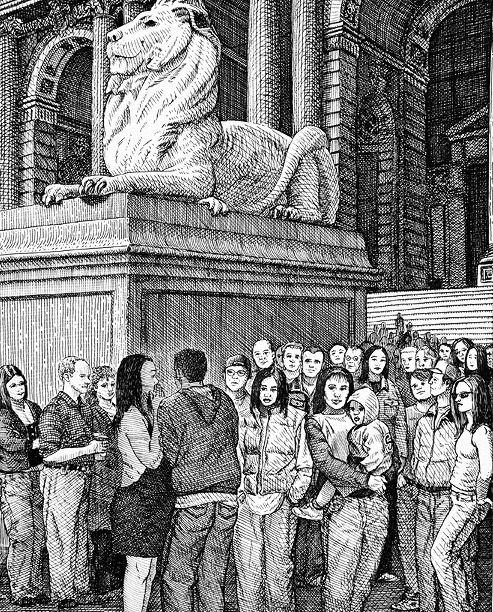To Hell and Back: Sandow Birk’s Divine Comedy
February 18, 2012 through September 16, 2012
Inferno
No other city in America epitomizes Birk’s version of Hell better than Los Angeles. Consumer excess and corporate logos are unapologetically on display, while balmy weather, sandy beaches, amusement parks, and abundant shopping meccas make it hard to stay away from the city. While a little indulgence does not constitute a sin, Birk conjured a vision of Hell through an extreme depiction of places and things that make up daily life in Los Angeles. He referred to the city’s obsessive car culture and network of freeways by depicting the Gates of Hell as the entrance to an underground parking lot. Stereotypes often used to portray Los Angeles as dreadful – rundown strip malls, Hollywood chintz, chain-restaurants, and congested roadways – here evoke the nine circles of Hell and emphasize the sinful temptations lurking throughout society.
Purgatorio
San Francisco, known for its beauty and cultural cache, can take scant pride in its local public transportation system; commuters and travelers often wait in limbo for the arrival of the next bus or train. Thus, Birk chose to begin Dante and Virgil’s journey to Purgatory by way of a Muni bus. Urban and natural environments – the hilly topography and distinct neighborhoods allude to the Mountain of Purgatory and the terraces of the seven deadly sins featured in Dante’s original tale – and noted landmarks such as the Transamerica building and Bay Bridge explain why San Francisco is a popular destination city. An attitude of invention and reinvention is an additional part of its appeal. Yet, the city has always had an air of transience, its population dominated by renters rather than settlers and noted for tolerance for the homeless. Many of Birk’s illustrations show the city’s citizens crawling or lying on the ground – perhaps visitors who ended up staying, for better or worse.
Paradiso
Despite the West Coast’s growing influence over the rest of the country, everything still revolves around New York – even in Heaven. In his opening drawing for the Paradiso, Birk placed the borough of Manhattan at the center of the Ten Celestial Heavens of Paradise. The Empyrean – God’s heavenly realm – shines brightly over the grandeur of the city, yet Birk ignored famous icons such as the Statue of Liberty, Central Park, and the Empire State Building in favor of the neighborhood park scenes, street encounters, and chance occurrences that give New York its vibrancy, energy, and unique character. In Birk’s view, Heaven is not filled with angels, saints, and the faithful, but with ordinary people: the stranger on the subway; the street performer and his captive audience; the lonely man standing near a lamppost; and the security guard who gives out unsolicited advice. For Birk, Heaven is all around us on Earth.


